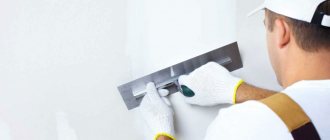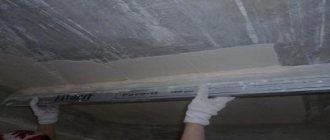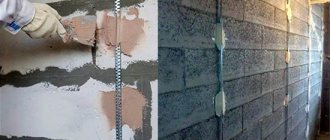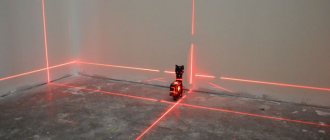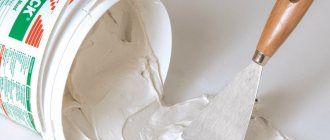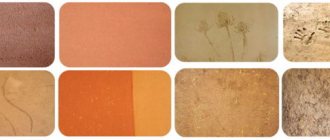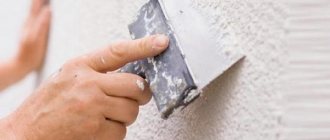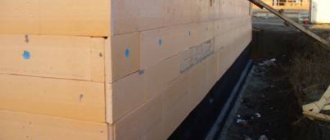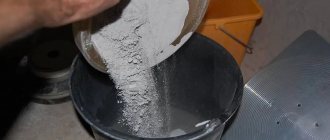Installing beacons for plastering walls seems to beginners to be perhaps the most difficult and incomprehensible task. And, although displaying beacons is a responsible task, however, it is not too difficult to master and do it yourself. A beginner needs to understand the intricacies of marking and creating an auxiliary plane, after which the rest of the work will no longer be so mysterious.
How to place beacons under plaster
A beginner, when starting to level walls, has little idea how to install the beacons, at what step to place them, or how to attach the guide profiles to the wall surface. The placement of beacons under plaster must be taken seriously, since only correctly aligned guides will allow achieving the required evenness of the walls. An incorrectly installed beacon (crooked or insufficiently fixed) becomes the cause of defects.
Let's talk about which beacon pitch to choose. The distance between the planks should be chosen based on the length of the rule with which you will level the plaster mixture. It is better for beginners to use a short tool (up to 1.5 m). This rule is simpler and easier to manage.
Since the rule is supported and moved along the beacons during alignment, the maximum pitch of the guides is set less than the length of the rule bar by 20 cm (up to 1.3 m). The minimum step can be any, most often it is 0.8 m. The distance of the outer guides from the internal corners is 10-30 cm. When installing beacons, they retreat from door or window openings by 0.1-0.15 m.
The main stages of placing beacons for wall alignment:
- mark the surface of the structure to be leveled;
- set guidelines for the outer beacons;
- at a short distance from the surface to be leveled, using levels, a plumb line or a laser level, create an auxiliary strictly vertical plane using laces (threads, rays of light);
- take measurements of the deviations of the wall surface from the auxiliary plane, find the “zero point” - the place where the surface protrudes most;
- the auxiliary plane is corrected, taking its elevation above the zero point by the thickness h of the plaster layer;
- install alternately two extreme beacon profiles according to the position of the adjusted auxiliary plane;
- install intermediate profiles, checking their position along the outer guides;
- prime the mortar part of the beacons (laps or mortar paths).
Installation of beacons with a plumb line.
The procedure for performing the work is the same as with a bubble level. Using a plumb line, vertical lines are set in one or two planes. Two planes are needed, for example, when installing doors, pillars... We only need one plane. At the site of the proposed lighthouse, we will draw a plumb line. Drill holes at the top and bottom. Let's tighten the screws. Drill another additional hole above the top screw. We fasten a long screw and attach a plumb line to it. When the plumb line stops dangling, take a tape measure with a screwdriver. By unscrewing or tightening the self-tapping screw, we set the same distance from the plumb line to both screws.
We set the remaining screws of this line according to the rule. Using this method, we align the screws only on the extreme lines. All other screws are aligned exactly the same as with a bubble level.
How to place beacons under plaster walls without a laser level
The main thing here is to correctly align the beacon profiles under the plaster.
Like any installation technology, the installation of beacons for plastering walls includes marking the area with the subsequent alignment and fastening of profiles to the surface.
Before the advent of laser levels, plasterers used a plumb line and a ruler to mark, driving nails into the wall, the heads of which, aligned in the same vertical plane, served as a guide. In addition to the plumb line, a building level is used to check verticality.
To install beacons for plastering walls, two main marking methods are often used:
- regular markings;
- spider method.
Methods for marking beacons
Regular markup
Let's look at how to set beacons in the usual way. You will need a level and a nylon thread. Our task is to create a strictly vertical auxiliary plane, spaced from the “zero” point (see gallery below) at a minimum distance (h) - the thickness of the solution. For different plaster mortars, h is different (usually indicated on the packaging of the dry mixture as the minimum thickness).
Taking into account the fact that the beacon profiles already have their own height b (mm), formed by the heads of the screws, the auxiliary plane should rise above the zero point by (h – b) mm.
- We retreat from the corner of the room 10 cm, from the ceiling 15-20 cm (point A). Similarly, on the other side of the wall we mark point (B). At both points we install a self-tapping screw protruding 3-5 cm above the wall.
- We attach a plumb line to the first screw, and under the thread we mark two new points (A1 and A2): the first at a distance of 0.15-0.2 m from the floor, the second in the middle between A and A1. We screw in the screws. Similarly, mark points B1 and B2 and install two more screws.
- At this stage, you need to align all the caps in the same plane. To do this, we pass the cord of the plumb line tied to the upper screw over the head, and screw in or unscrew the underlying screws so that their heads touch the cord passing above them. We do the same with the screws on the other side.
- We stretch a horizontal line (lace) between the opposing screws, passing it over the caps. We connect the fishing line and the diagonals (A-B1 and A1-B). If the hardware is installed correctly, the diagonal lines will touch in the middle.
- We mark points C and D (10 cm to the center from A and B under the horizontal line). We also install on self-tapping screws with caps adjacent to the fishing line (for convenience, we draw lines between the screws with a marker). Having measured the distance CD, we divide it into segments of length from 100 to 150 cm (the distance between the beacons). We install the hardware, focusing on the fishing line.
- For all new screws, repeating the operations described above, we install a pair of lower beacons on the lines.
- The resulting vertical plane makes it possible to identify the most protruding point of the wall (zero), which is determined by measuring the distances from the wall to the plane formed by the fishing lines.
- If the distance between the zero point and the vertical plane is greater than h or hb, we adjust the position of the plane by screwing or unscrewing the hardware to the same distance.
Marking points A1 and A2
Installation of self-tapping screw
Pulling the lace
Marking points C and D
Determining the zero point
If clips are used to attach beacons, then the thickness of the clip plate is also taken into account.
Screwing and unscrewing screws simultaneously is not difficult. It is enough to tighten or unscrew them by the same number of turns, because the thread pitch of the self-tapping screws is the same.
Spider markup
Installation of beacon strips for plastering walls is carried out in another way - the “spider” method. The name arose due to the use of four (two horizontal, two vertical) stretched threads. However, if everything is done carefully, high accuracy is achieved. The method will help to determine the optimal thickness of the coating for leveling, which means that the consumption of plaster on the beacons will be minimal.
- Having retreated from the corners of the wall (and from the ceiling) 15 and (5) cm, mark points, drill a hole in them, then, inserting a dowel, screw in 2 self-tapping screws with a screwdriver so that the caps rise above the wall by 5 cm.
- Now you need to use a plumb line to mark a place above the wall, 5 cm from the floor, for installing two more screws (strictly vertically, under the top ones). Holes are drilled into which self-tapping screws are installed, protruding from the wall also by 5 cm.
- At a distance of 2 cm from the wall surface, a nylon thread is tied to the upper screws. Using a plumb line, notice on the lower screws the places where you need to tie the nylon thread coming from above, so that it is strictly vertical. In these places the ends of the threads are tied with tension.
- A pair of horizontal threads is tied to two threads stretched vertically so that they can be moved. By moving horizontal threads along the wall, they reveal the curvature of the surface, the maximum protrusion (zero point), as well as whether the wall is collapsing and in which direction.
- If the distance from the zero point to the horizontal thread is greater than the minimum possible layer thickness for the selected plaster (h for beacons made of mortar, or hb - in the case of using standard profiles, where b is the height of the flange of the beacon profile), screws are screwed deeper into the wall at the same distance, ensuring that the horizontal thread is positioned above the zero point by the amount h (or hb). If the zero point protrudes beyond the vertical plane formed by the threads, the protruding section is cut off, or all screws are unscrewed to the same distance.
- Along the created vertical zero plane, 3-5 self-tapping screws are placed under each thread, the heads of which touch the threads.
Installation of 2 screws
Marking the space for screws using a plumb line
Attaching a horizontal thread
Installing screws under the thread
Setting up intermediate beacon profiles along two precisely oriented lines is no longer difficult. You can place beacons in the gap under horizontally stretched threads. Any beginner can handle this.
Beacons on self-tapping screws for screeds
Basically, the process differs at the preparation stage - you need to determine the level of the screed and beat it on the walls. When determining the thickness, it is worth remembering that the minimum layer of mortar on the floor must be at least 3 cm. Otherwise, there is a high probability that the concrete will begin to crack.
After you have decided on the level of the screed, place a mark on one of the walls. Next, using an electronic level (set to horizontal plane mode) or a water level, transfer the mark to all walls and connect them with lines. Next, self-tapping screws are installed at these marks, strings are tied to them, and installation and alignment of the screws on the floor begin.
How to place beacons on screed screws
The number of beacons for floor screed is determined in the same way: based on the length of the rule: its length is minus 20-30 cm. The beacon strips are placed perpendicular to the wall in which the entrance doors are located.
After all the screws are installed and aligned in a single plane, piles of mortar are also placed near them. But not the one that will be used for screed, but the one that sets faster - you can use alabaster-based plaster. Next, you need to set the beacons in the same way as for the walls: press them in until they reach the caps, check the level.
How to place beacons under plaster walls using a laser level
One of the modern marking tools used is a laser level. Using it, placing beacons under plaster walls is much faster and easier. You can also use a laser level to set a right angle between adjacent walls. You will need a rule 5-10 cm long less than the height of the wall. The device is placed perpendicular to the wall near the corner (if the wall is short) or in the middle (if the surface to be plastered is long).
We install the laser level as close to the wall as possible (3-4 cm) so that the plane created by its beam is parallel to the one being processed and perpendicular to the adjacent, already plastered wall. We mark with a pencil the places where the lines of light pass, so that when knocking down we can place the device in the same place. Using a metal square, we measure the deviation of the wall surface from the plane formed by the beam, recording the results on the surface or in a notebook.
- Having identified the zero point, we mark it with a cross, measure or calculate the distance from the light plane to the future surface. Let’s say that from the zero point to the beam is 25 mm, the plaster layer is 10 mm, the height of the beacon profile is 6 mm. We calculate the minimum distance between the beam plane and the top of the beacon ribs: 25 – 10 = 15 mm (see figure).
- To mark the rule in three places, glue masking tape onto its plane, onto which we apply a mark spaced 15 mm from the working edge (or draw a line directly on the rule, spaced 15 mm from the edge). The beam must pass along this mark when setting the rule on the edge of the beacon being set.
- We draw beacon installation lines on the walls. We throw along the line furthest from the level the solution. We install the profile bar by slightly pressing it into the solution.
- We set the rule with the edge on the edge of the profile and press the profile against the wall with the tool so that the laser beam coincides with the marks on the tape.
- We set aside the rule, remove excess solution, clean the top of the beacon with a spatula so that the working surface is clean and smooth.
- We install the following profiles in a similar way, sequentially approaching the level.
Zero line
Attaching grafted to the lighthouse
Combining the line on the rule and the laser beam
Removing excess solution
Installing a beacon on a solution
Marking beacons is done with a laser level several times faster than other types of marking.
Where you need a 90 degree angle between walls
90 degree angles are generally not displayed everywhere in the apartment. In economical repairs, and in most euro-renovations, 90-degree angles are needed only in two places:
- in the corner where the kitchen furniture will hang/stand,
- and in the bathroom, where the bath itself will be located, in two adjacent corners (or in one if the shower stall is in the corner). Or in all 4 corners of the bathroom, since there will be a sink, washing machine, etc.
In other cases, everything is at the request of the customer or the person carrying out the repairs on their own.
Types of plaster beacons
Beacons made of different materials are used as guides when leveling walls.
It can be:
- mortar (tracks made from mortar, the top edge of which serves as a guide);
- metal profiles (made of aluminum or galvanized steel);
- plastic profiles (disadvantage - they bend easily);
- wooden slats (rarely used, secured in place with nails);
- strings.
Types of lighthouses
All types of beacons have advantages and disadvantages. It is not recommended to leave beacons made of metal in the plaster; they are removed after the composition has set. Profiles left behind will corrode over time, causing rust spots to appear. Wooden slats can swell and warp from moisture. Plastic profiles warp too easily, making them more difficult to install and secure accurately.
In addition to T-shaped beacon profiles, L-shaped ones are produced. They are installed on plastered protruding corners. After leveling, the L-shaped profiles are left in the thickness of the finish.
Metal beacons come in lengths of 3 or 6 m. They are cut to size before installation.
Installation of beacon profiles on plaster mixture
Along the leftmost beacon line, in increments of 0.4-0.6 m, mortar cakes are applied so that their level is higher than the intended control plane. The profile cut to size is inserted under the cords and lightly pressed against the flatbreads until fixed. Then a rule with a bubble level is applied longitudinally to the beacon being installed and, with uniform pressure, it is sunk into the solution to the required level. If, due to excessive force, the beacon has dropped lower than it should, add a solution under the profile in the places where it rests on the flat cakes.
At the end of the operation, the same procedure is performed on the beacon line at the right corner of the wall.
For beginners, to facilitate control, it is recommended to stretch a horizontal thread between the vertical cords, which can be moved up and down along them. After this, linear beacons are installed along intermediate beacon lines, controlling the position of the profiles using a moving thread.
Preparing the wall surface
Before placing beacons for plaster, the surface to be leveled is prepared. Get rid of unusable old coating, stains, mold, and excess metal parts. Cracks and chips are repaired. Smooth concrete surfaces are covered with notches, and the joints in the masonry are embroidered to a depth of 10 mm.
Details about plastering walls made of different materials:
- Plastering brick walls.
- Concrete walls.
- Plasters for wood.
Remove dust from the surface, dry it, the base must be primed and, after drying, reinforced (if necessary).
Installation of beacons
After the primer has dried, you can install beacon strips. In most catalogs of building materials they can also be found as a beacon profile “PM 23x6”. “23” is the width of the base, “6” is the height of the lighthouse in mm. If you are plastering large protrusions, the beacon can be taken at 10 mm. The standard slats are 3 m high.
The beacon is installed in a vertical position. The rail is attached to the wall on alabaster, placing construction plaster at several vertical points for one lighthouse.
The placement of beacon slats begins with attaching two slats to the wall at opposite ends of one wall. For this:
- Mix a small amount of gypsum with water;
- We apply the mixture to the wall at several vertical points in the place where the beacon is supposed to be attached;
- We immediately attach the beacon to the alabaster.
The evenness of the beacons, their verticality and horizontality should be checked using a building level.
These works are carried out at a pace, but not in a hurry. If you do plastering yourself, without much experience in finishing work, you need to be especially careful.
So, you have secured two beacons at opposite ends of the wall. The attachment points from each other should be at a distance of no more than 50 cm. If you are installing the profile not on a brick, but, say, on a plasterboard, you can attach it using ordinary self-tapping screws, slightly pressing them so that the beacon does not bend. Between the two installed beacons, two parallel threads are stretched, at the top and bottom.
The remaining center beacons must be installed as follows: the top of each profile after installation should lightly touch the thread you pulled. The distance between the profiles is determined based on the parameters of the plastering tool that you are going to use. If you work as a rule with a length of 2 meters, then between the beacons there should be a space of 180 cm wide.
This completes the process of preparing for plastering.
Installation of beacons for plastering walls in different ways
When installing, the main thing is to securely fix the beacon profiles to the wall. To reliably, quickly and accurately install the beacon on the wall, use ready-made or home-made fasteners, for example, eared ears, clips. Often the installation of beacons for plastering walls is done using mortar.
To prevent the solution on which the profiles were installed from serving as an accelerator for the crystallization of the plaster composition applied during plastering, the flashings are coated with a primer after installing the beacons.
Installation on plaster mortar or tile adhesive
Let's look at how beacons are placed, when they are installed and fixed using a plaster mixture. If you install the profile directly on the screw caps, it may rotate during the fixation process, deviating from the correct position. Therefore, piles of plaster composition protruding above the caps are laid around the hardware with a spatula.
Round or rectangular “bedside tables” are formed from the slides; the top is cut off along an auxiliary vertical plane at the height of the caps. On such hardened bedside tables, it is much easier to place beacons under the plaster and secure them with plaster mixture or tile adhesive.
After installing the plaster beacons on the marks, fix the position of the profiles between them. Pieces of cut drywall can be useful here, from which you can make a mark of the required height by gluing the pieces with a solution or adhesive mass. If the beacon profiles are located close to the surface of the base, it is enough to place a mortar mixture under them in the right places.
Installation of beacons without mortar
Since our task is the reliable installation of beacons with protection against displacement during the plastering process, we need quick, strong fastening of the profiles to the self-tapping screws. For this purpose, several types of fasteners have been invented.
You can install beacons on hardware using:
- clips;
- creamers;
- eared;
- cleverness;
- homemade brackets made from straightened and cut beacon profiles.
The advantage of such fastening is the speed of installation, the absence of the need to wait for the plaster mixture to harden. In other words, it is enough to install the beacon profile and secure it with the fixing parts on the screws, and almost immediately after installation you can begin plastering. Beacon profiles installed on the walls will no longer move.
The disadvantage of such fastening compared to fastening to a plaster mixture is that it requires the installation of additional hardware, as well as the purchase of clamps.
Lighthouses from solution
You can make your own beacons for leveling walls using a plaster composition, for example, gypsum or cement. Such paths, made from the same plaster composition that will be used for subsequent plastering, do not need to be removed.
The easiest and fastest method is suggested by Andrey Shaiter.
To make guides from mortar, only a rule, a spatula and a trowel are used. The axes of the beacons are first marked on the wall, the zero point is found using a laser device, an auxiliary plane is set, and marks are made on the rule. Before starting work, prepare a viscous elastic solution.
Step-by-step production of a mortar beacon using the Scheiter method:
- the rule is installed on the edge (fixed in this position on the scaffolding);
- use a trowel to apply a solution to the upper edge of the rule;
- apply the correct bar with the solution to the wall, pressing until the line on the rule and the laser beam are aligned;
- using a rectangular trowel, adjust the angle of contact between the rule strip and the wall (to achieve the formation of a perpendicular);
- use a spatula to remove excess mortar from both sides of the instrument;
- using cotton threads, cut off the edge of the rule from the created mortar path, remove the rule;
- Allow the solution to dry for a day, after which they lightly pass along the top of the beacon with a block of sandpaper.
Fixation rule on scaffolding
Application of the solution
Adjusting the contact angle
Combining the line on the rule and the laser beam
Cutting off the rule from the track
This method creates mortar paths 2 cm wide. Made from gypsum, they dry out within a day and become suitable for plastering. During manufacturing, it is recommended to rest the lower end (heel) of the tool’s strip on a wooden wedge to avoid displacement of the strip when cutting with a thread.
Another method of making mortar guides and controlling their vertical level is somewhat more complicated.
- The rule bar is attached to the pre-installed screws to the wall (perpendicularly, on the edge).
- The gap between the plank and the wall is filled with mortar (without gaps).
- Use a spatula to remove excess plaster longitudinally from both sides.
- Gently tapping, shift the rule along the axis of the beacon, and then remove it from the formed path.
We start marking from the first wall
First of all, let's check our first wall for verticality and plane. If we align 2 corners, then this is a wall parallel to the bathtub, if we align 4 corners (the entire area), then it is a wall with an opening. If the wall is blocked, it will need to be leveled first, but take your time, because we have not yet checked the entire area.
I recommend: How to make a sandbox with your own hands
To begin with, let’s simply cut a straight line parallel to the first wall, as close as possible to it.
Let's draw the first line parallel to the first wall
Next, between the first wall and the second wall, we will install a square with one edge parallel to the first line, and apply a rule to the second edge of the square. We combine the edge of the rule and the square, thereby “lengthening” our square. Draw a line on the floor to the end of the wall as close as possible to the wall. We adjust and combine our enlarged square so that:
- the line was straight
- minimum distance to the wall,
- the second edge of the square was parallel to the first line.
This is how we get the first right angle.
From the first line we will beat off the second one, perpendicular to it
Next, we go to the next corner to which we drew the line, and align the square with one edge parallel to the second line. We repeat the procedure with the rule (combine it with the square) and draw a third line perpendicular to the second, again as close as possible to the wall.
It requires some skill to combine the rule, the square and make a right angle with the lines as close as possible to the wall (this is done so that when plastering you don’t “eat up” the extra space). If the rule is not enough, we draw as far as there is enough, rearrange the rule, combining it with the line, and draw it to the end of the wall.
Draw a third line perpendicular to the second
We draw the fourth line, by analogy. As a result, we should end up with a rectangle
inside our premises. We check it along the first edge - along the wall with the opening, also by applying a square and a rule.
We check the resulting rectangle along the 1st edge
If everything is smooth, you can relax a little. If not, we repeat the procedure and/or look where we made a mistake.
Materials and tools
To plaster with leveling compounds and prime, use conventional plastering tools.
To install beacons you will need:
- plumb line (laser level or building level);
- nylon lace;
- a set of dowels and screws (the length of the latter depends on the thickness of the leveling layer);
- spatula and trowel;
- marker or pencil for marking;
- trapezoidal rule (10 cm shorter than the height of the leveled wall);
- solution container;
- screwdriver (for self-tapping screws);
- metal scissors (needed to cut the profile into pieces for making fasteners);
- perforator;
- chisel and pliers for removing metal guides;
- masking tape.
Installing beacons for plastering walls may require purchasing beacon profiles and a sufficient number of screws (of different lengths). In the case of making mortar paths or attaching guides to the mortar, you will need to stock up on dry plaster mixture or components for preparing the composition.
Preparatory process
During the work process, the following tools will be useful to you:
- spatula and trowel;
- building level;
- drill for stirring the solution and hammer drill;
- 2 rules: the length of one is slightly less than the height of the wall, the second is shorter, for leveling the plaster;
- container for diluting the solution.
Inspect the walls to identify any protruding areas. Various peelings of the old coating in the form of plaster or paint are removed with a chisel. You also need to get rid of the influx of solution. Before starting work, the surface of the walls is treated with a primer to improve adhesion to the plaster.
There are two common ways to correctly position beacons under plaster: installation is carried out using fasteners or using a solution. Let us consider in detail what the features of the process are.
Rules for plastering lighthouses
Leveling the walls by plastering is carried out following the rules developed over centuries.
- The plaster should not be stronger than the base material. During hardening and strength gain, internal stresses arise in the composition, which can be destructive for a weak base.
- The base surface must be carefully prepared before plastering. Any negligence will lead to the appearance of cracks, peeling of the plaster layer or the appearance of stains, efflorescence and other defects in the plaster.
- Applying a primer to patches, mortar marks, and mortar paths is mandatory.
- It is better to place beacons under the plaster slowly, especially paying attention to the accuracy of the geometric constructions.
- When plastering, the solution is applied evenly, spreading without leaving gaps.
- The strip between the guides is plastered in small sections, since otherwise too much excess mortar will accumulate on the rule. This may cause the instrument to become deformed.
- It is necessary to rest the rule on the guides only with slight pressure, so as not to damage the tops of the profiles.
- After leveling the mixture from bottom to top, one leveling is performed in the opposite direction, which ensures the mixture is fixed to the wall and prevents the composition from sliding.
- The profiles are removed until the plaster gains strength.
- The resulting grooves are filled with a solution that is more viscous than when plastering.
- If plastering is done with gypsum, then the excess is either immediately thrown onto the wall where the mixture is missing, or thrown into a separate container. The gypsum composition, which has already been on the wall, can cause the freshly prepared solution to instantly set, becoming the center of crystallization.
From all of the above, it is clear that the correct installation of the outer guides becomes the basis for the correct exhibition of intermediate beacons for plastering walls with your own hands. Having successfully completed the beginning of marking work, beginners usually get a taste for it and work with great pleasure, because the result - perfectly maintained geometry - is inspiring.
How to create corners in a bathroom: all corners are 90 degrees or just two
Now that we know what threatens us, we can try to make markings at 2 angles and see what threatens us in this case. We do everything the same, only for the main, first wall we take the one opposite the opening (the wall parallel to the bathtub).
- Draw a line parallel to the first wall.
- We set the square and the rule at two corners.
- Draw lines to the wall with the opening.
Let's see what happens if we align 2 corners
This is what happened. We place the wall with the opening and the wall opposite only in the vertical and 2 corners of 90 degrees, where the bathtub is. The consumption of plaster and labor costs is less. The corners adjacent to the wall with the opening are not so scary. If there is a gap, it is small.
Deciding on the angles
Let’s decide whether we will draw right angles only where the bathtub is or in all corners. We pay attention to the other side of the wall, which is in the corridor. If the wall with the opening is blocked, then the second side of the wall will need to be plastered in the same way and brought vertically, otherwise the door will not be able to be installed smoothly.
I recommend: How to assemble a frame from a profile in the corner to cover the riser pipes?
Important point
, if you start from the wall with the bathroom, then it will no longer be possible to bring out the corners with the wall with the opening, because starting from the wall with the bathroom, all the irregularities will “crawl out” onto the wall with the opening and it may turn out that on one edge of the opening the thickness of the wall will be 10 cm, and on the other 15 cm. And how to install a door in such an opening is completely unclear...
You need to start leveling the walls from the wall with the opening, if you are leveling all the corners, and if only two corners, then the wall parallel to the bathtub should be leveled first.
A little about the choice of material
Various types of plaster solutions are used to level the walls. Each of them has its own characteristics that must be taken into account when choosing it.
| Type of plaster | Main components | Advantages | Flaws |
| Plaster | Gypsum and lime | Economical consumption, easy application Retains heat well Used on a variety of substrates Convenient for painting | Softness Low resistance to damage High moisture absorption capacity |
| Cement and cement-lime | Cement, lime, sand | Effective when decorating rooms with high humidity High resistance to mechanical damage Most effective under tiles and wallpaper | In dry rooms they quickly crack and crumble. Responsive to temperature changes Low resistance to damage |
| Clay | Clay, sand | Environmentally friendly, rarely used High breathability Creates a healthy indoor climate Resistant to fungi and mold Does not cause allergic reactions | Very heavy Absorbs and retains odors, including unpleasant ones |
Each leveling mixture has its own characteristics
Preparatory work for leveling walls
Before you start leveling the walls along the beacons using plaster, the working surface must be prepared.
First, wallpaper, tiles, paint and any other decorative coating are removed. If the walls are plastered, it is best to completely remove the old layer. In cases where it is not planned to remove all the plaster, it is necessary to identify and clean loose and swollen areas. After this, you need to clean the wall from dust and construction debris; for this you can use a broom or vacuum cleaner.
If the wall is severely damaged, there are deep depressions or, conversely, bumps in it, it is necessary to carry out rough leveling. To do this, you will need plaster to cover all the recesses, and a hammer to knock down the convex areas. Before applying a layer of plaster to the wall, the area is treated with a primer.
After rough leveling, the wall should be cleaned of dust again and then completely covered with a layer of primer. This is done in order to ensure better adhesion of the plaster to the wall surface and protect it from moisture.
Construction of brick beacons
We talked a little about the devices, now we will talk about how fines are made and how bricks are laid on beacons.
What exactly is an inclined brick slab? This is a fragment of masonry, the side edges of which are not vertical, but represent a ladder of half-released bricks.
- Such elements are needed not only as a guide, but also for joining the masonry in the case when the wall is being built in parts. It is, of course, better to erect a wall along its entire length at once, but this is only possible when a large team is working, with plots distributed between its units.
- When the wall is long and there are only one or two masons working on it, it is inconvenient for them to constantly move from one place to another. Moreover, during the laying process you also have to go around the openings. In order not to waste time, it is much easier to manage first on one plot, and then move on to another section.
Sloping fence
- The ladder in the groove makes it possible to perform high-quality ligation of two fragments of masonry. The height of a standard fine usually does not exceed six rows of bricks - in any case, this is quite enough for beginners. Guided by the mooring stretched between the beacons, they complete the laying along the entire length of the wall to the height of the fines, after which they again begin laying out the beacons.
Let us note that highly qualified masons are able to raise the mortar along the entire height of the wall at once, which we, in fact, observe in the above example. In this case, no damage is caused to the quality of the masonry. However, an inexperienced person should not chase them - there will be a lot to learn first.
Nuances of calculating fines
The laying of beacons begins with a corner block, since correctly laid out corners are the key to all further work. The construction of a brick wall is carried out under the mooring line, and only after laying out the lighthouses. This applies to both the masonry of the main wall and the decorative cladding.
Note! How many lighthouses need to be pre-built depends on how the team’s work is organized. If several units are working simultaneously, then beacons are placed not only at the corners of the openings, but also at the border of each plot.
- The first row is always bonded, and on the intermediate lighthouse it consists of 13 bricks . When ligating sutures in multiple rows, the second and subsequent rows of stitches will be spoon-shaped. In the second row of the lighthouse fragment there will be 6 bricks, in the third 5, in the fourth 4, in the fifth 3, in the sixth 2 bricks. In this case, the outer bricks of each row are laid offset, resulting in a ladder.
Corner and intermediate beacons
- Laying a corner in one brick always begins with an incomplete brick - three-four . This makes it possible not only to connect the first rows of two adjacent walls, but also to qualitatively bind the masonry. Here, too, the first rows will be bonded, and on each side they will consist of 9 bricks.
- In the second rows, there will be only 4 spoons . And then their number decreases until in the sixth row there are 2 bricks left on both sides. Since masonry always begins from the outer (front) mile, the running of the spoon rows on beacons is carried out along the outer edge of the future wall.
After the arrangement of the grooves is completed, a mooring cord is pulled between them, and the laying of spoon rows is carried out flush with the upper rows of lighthouses. Then the spoon rows of the inner mile are laid out in the same way, after which the finished section of the wall is tied with a butt row. Then everything is repeated: beacons are erected, then the outer, and then the inner mile - and again a row of studs.
Source
Devices for masonry control
Before talking about how to set up beacons for bricklaying, I would like to pay attention to such simple but very important devices as the order and the mooring cord. Let's briefly tell you what they are, since without them it is impossible to correctly lay out beacons - not to mention walls.
Order
The order is a strip or corner profile with divisions applied to it. The distance between them corresponds to the height of the brick, plus the thickness of the horizontal seam. For a single brick, the order marking is carried out as follows: 65 mm + 12 mm = 77 mm. For one-and-a-half or double bricks, the distances between divisions are marked in accordance with their height.
- In general, with the help of orders, which can be angular or intermediate, the height of the masonry row is controlled. They are installed at the corners of the building being built, as well as in those places where there will be openings, or where transverse walls will be connected.
- Such devices, together with the mooring cord, can be purchased factory-made, or you can make them yourself - from an angle profile, a wooden batten, or a pipe, which are attached with clamps first to the base, and then to ready-made lighthouses.
On homemade orders, marks are made in the form of a serif, a through hole, or simply mark divisions with a marker. Despite the fact that the device has a cheap price, it plays a very important role when building brick walls.
Mooring
The option with holes on the ordering bar is the most convenient - you can tie a nylon thread to them, which will serve as a mooring. Although, the options for fastening the mason's cord, one of which is shown in the photo, can be different: staples, special corners.
- The purpose of the mooring cord is to visually draw a line at the top edge of the brick course. To install lighthouse fragments of masonry, which are called inclined (safety) grooves, it is installed in each row. And when bricklaying is carried out along the beacons, the thread is pulled after two or three rows.
Mooring cord attachment option
- The most important thing here is to avoid sagging of the mooring, which can create considerable problems. As a matter of fact, it is precisely this fact that forces the installation of lighthouse fines - after all, the longer the wall, the more difficult it is to provide the string with the necessary degree of tension. Note that working with a twisted cord like the one in the picture below, which is strong enough and practically does not stretch, is much easier.
Note! Many masons use ordinary nylon thread as a mooring, which inevitably sags as a result of strong tension. If it does not make a characteristic ringing sound when touched, then you can be sure that there is sagging in the center.
- It is almost impossible to determine it visually, but when a row of bricks is laid along such a mooring, it turns out that in the middle the thickness of the seam has decreased significantly. Accordingly, in the next row the seam will be thicker than necessary. Maybe when doing working masonry intended for plaster, this is not so critical, but on facing masonry such a difference in the thickness of the joints is simply unacceptable.
Factory-made mason's cord
Even a well-stretched mooring cord cannot always ensure control of the horizontal rows. Weather conditions can also become a problem – for example, strong winds.
That is why, in order to get rid of complications and not have to redo the work, intermediate beacons are needed. We hope that the instructions we offer in the next chapter will help you understand the intricacies of their arrangement.
How to check the evenness of a leveled surface with a laser level
To check the evenness of the created plane, you need to place the laser level on a flat surface. After that, turn it on in the “vertical axis” mode. After this, the level is placed to the wall at 45 0. The laser will show the evenness of the surface. If there are errors, the beam will deviate.
Plastering a wall is an important stage in repair work and construction. After all, the appearance of the room depends on the flat surface. Irregularities in the wall after plastering are difficult to hide with putty or a finishing coat. Therefore, the plasterer’s work must be precise and correctly structured. To create a single plane, beacon profiles are used. Depending on the professionalism, various methods of attaching beacons to the wall are used. But all methods come down to one thing - evenness. Constant checking of the level and the rules will make the walls smooth, ready for subsequent finishing.


